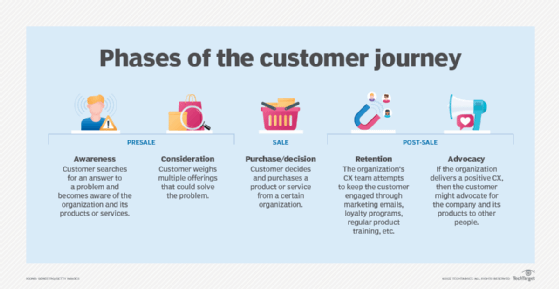
Getty Images
How to find the customer journey moments of truth
A moment of truth can turn a potentially positive experience into a negative one, and vice versa. Understanding moments of truth requires a complete knowledge of the customer journey.
A customer journey can have many touchpoints, and any of them could send the interaction off track and lead to a poor experience.
Organizations can ill afford to let this happen. Three bad experiences are all it takes for a customer to leave a company for good, according to Metrigy's research. CX professionals might consider any customer journey touchpoint to be a moment of truth, or a point in which a customer makes an experience-based decision -- whether good or bad. Most organizations have a lot of work to do around the customer journey and, therefore, their moments of truth.
What is a moment of truth in customer service?
In a moment of truth, customers might ask themselves the following questions:
- Do I buy this product or look at alternatives?
- Do I continue in self-service mode or escalate to a phone call?
- Do I share feedback on this experience or get on with my day?
For many organizations, the customer journey begins when the consumer engages with the contact center. They have no visibility into a consumer's relevant activities prior to that initial email, phone call, text message, webchat or other interaction channel. But activity outside the contact center is just as significant as the interaction and post-interaction events.
What are the types of moments of truth?
CX professionals should consider several different moments of truth throughout the customer journey.
1. Less than zero moment of truth
Consider again the "three strikes and you're out" mentality of modern consumers. Many of them take action after a single bad experience. In Metrigy's "Customer Experience Optimization: 2023-24 Consumer Perspective" study, 44.4% of consumers said they tell friends and family about their bad experiences.
With this tale of woe, another consumer's journey with the company begins. Presumably, the journey will be short-lived. From this conversation, they likely formed a negative impression that could last well into the future and lead them to decide not to do business with the company despite having no personal experience with it.
In marketing circles, this scenario is known as a less than zero moment of truth (LZMOT). CMOs, CX managers and other business leaders then must attempt to intercept customers before they share bad experiences to avoid limiting their pool of potential customers. This can be tough, but perhaps not as difficult as preventing the LZMOT caused -- consciously or not -- by external forces, like potentially negative effects of the media, social network posts, ads, etc.

2. Zero moment of truth
Consumer reactions to bad experiences also come into play in the next stage: the zero moment of truth (ZMOT). This, too, takes place ahead of an actual engagement. This is when customers actively research products and services.
Metrigy's research shows that 26.1% of consumers leave negative reviews on rating websites and 12.4% post on social media after a bad experience with a company. These ratings and posts are problematic for companies, and CX leaders should create formal processes to stay ahead of them.
At this early stage of the customer journey, many CX leaders use search analytics to measure how many people visit help pages, which can help them better understand consumer behavior. Likewise, they monitor social networks -- such as Instagram, LinkedIn and TikTok -- as well as third-party ratings and other websites for references to their products and services. They also have formal outreach programs to gather customer feedback.
3. First, second, interim and third moments of truth
Other moments of truth in a customer journey include the following:
- First moment truth: The first time a consumer interacts with a product or service, whether in a physical location or online.
- Second moment of truth: The first time a consumer uses the product or service.
- Interim moment of truth: Points at which the consumer engages with the contact center.
- Third moment of truth: All post-purchase activity.
How to identify moments of truth
Organizations have an array of technology options and strategies to help them understand the customer journey and moments of truth. These include the following:
- Customer journey mapping tools. These tools can visually identify touchpoints end to end to better spot opportunities to engage with consumers for an improved experience.
- API-based proactive outreach. With this strategy, contact center agents can send voice or text messages at key moments -- for example, sending a purchase incentive or a post-purchase loyalty perk.
- Visual engagement. Activities such as co-browsing, screen sharing or video calls can help consumers fill out forms or agents diagnose problems and direct them to fix a product issue.
- Customer feedback. With voice of the customer or other customer feedback tools, teams can gather information and analyze customer sentiment in the moment -- with AI assistance -- or over time.
- Social listening tools. These can quickly discover who's saying what about the organization and either encourage positive messaging or discourage negative postings.
Many organizations understand the value of using technology to make customer journeys more seamless. With these tools and strategies, a better understanding of and responses to moments of truth should follow.
Beth Schultz is vice president of research and principal analyst at Metrigy. She focuses her research on unified communications, collaboration and digital customer experience.






